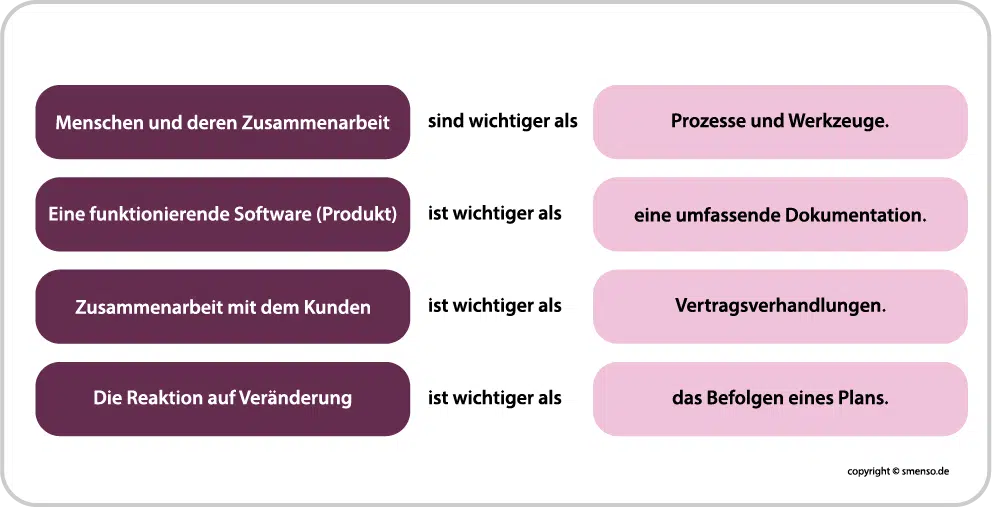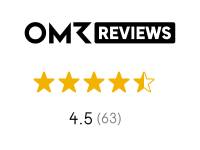What is agile Project Management?
The agile project management originates from the practical experience of software development, where constantly changing conditions and requirements are common. Agile practices and methods have become widely accepted and successfully implemented in the software development field, especially through the “Scrum” methodology, which has gained popularity.
In the year 2001, 17 experienced and knowledgeable software developers published the “Agile Manifesto” (original “Manifesto for Agile Software Development”), which included renowned figures like Jeff Sutherland and Ken Schwaber, the founders of the Scrum framework, and Ken Beck, the creator of the agile method Extreme Programming. Based on their extensive experience in executing software projects, they formulated a set of ideas, principles, and values that aimed to improve software development practices and laid the foundation for agile project management.
Zu den Prinzipien und Werten im “Agilen Manifest” zählen u.a.:
- Our highest priority is to satisfy the customer through early and continuous delivery of valuable software.
- Focus on interactions and collaborations among users rather than solely relying on processes and tools in software development.
- Agile processes promote sustainable development. All stakeholders, developers, and users should maintain a consistent pace indefinitely.
- Face-to-face conversation is the most efficient and effective method of conveying information within a development team, outweighing contract negotiations.
- Working software is valued more than comprehensive documentation.
- Functioning software is the primary measure of progress.
- Embrace changes and respond quickly to new requirements rather than rigidly adhering to a fixed project plan.
- Business experts and developers must collaborate daily throughout the project.
- The best architectures, requirements, and designs emerge from self-organizing teams.
Agile Project Management: Digital, Fast, and Easy with One Tool. Test smenso for free with your team.
In recent years, various methods and techniques have been developed to put the values and principles of the Agile Manifesto into practice. Some of these include, but are not limited to:
Methods
- Scrum
- Design Thinking, Design Sprint
- Lean Startup, Lean Thinking
- BMC (Business Model Canvas)
- FDD (Feature-Driven Development)
- OKRs (Objectives and Key Results)
- Lean Coffee, Fishbowl, Pecha Kucha
- …
Techniques
- Task Boards / Kanban
- User Stories, Use Cases, Persona
- Daily-Standup-Meetings
- (WIP-Limits) Work-in-Progress Limits
- Burn-Down-Charts
- …
Since around 2010, various organizations involved in standardization and certification in project management have recognized these developments and defined them under the term Agile Project Management. As a result, there is, among others, a certification for “Agile Project Managers” (PMI-ACP) offered by the renowned Project Management Institute (PMI).
Agile Project Management and its elements
To gain an understanding of what lies behind agile project management, it is easier to distinguish between agile values, principles, techniques, and agile methods. The following graphic illustrates the systematics of agile project management.
Agile Values:
The agile values reflect the essential principles and form the foundation of agile project management: More flexibility in projects and fewer rigid structures.
Agile Principles:
They describe the fundamental approach to agile project management. These principles include iterations and the desired self-organization of teams, for example.
Agile Techniques:
These are relatively easy-to-understand and concrete measures that are integrated into project management. The techniques provide structure to project management.
Agile Methods:
Are the foundations for structuring at the level of process models. Principles and techniques are combined here to create a specific process.
Agile Project Management: Digital, Fast, and Easy with a Tool. Test smenso with your team for free.
Change in Traditional Projects
Some may have wondered why there is a need for a different approach to project management when the traditional method has been used in many project areas and has proven itself over time.
Well, in traditional project management, it is assumed that stakeholders – simply put: the individuals interested in the project’s realization – have relatively high influence at the beginning of the project, but this influence diminishes significantly as the project progresses. For instance, the customer can specify what they want as the project outcome at the start.
As the project advances, their influence on the outcome decreases. This is because project results are defined in the contract, and the customer becomes less involved in the project. In traditional project management, the customer receives the outcome that the contractor understood as the project goal.
Furthermore, traditional project management assumes that changes to the project scope become more expensive the later they are introduced in the project phases. The following example of “bridge construction” illustrates this.
Change in Agile Projects
What applies to the “Bridge Project” does not necessarily apply to other projects. However, in recent years, it has been shown that projects implemented in the traditional project management approach can pose difficulties when stakeholder influence is limited, and changes incur high costs.
- One important reason for this is the increasingly rapid pace at which the project’s environment changes. If a company starts a project today based on a certain market situation, it is likely to have changed by the end of the project. The project’s outcome (which could be a product) may then only be of limited use.
- Moreover, it is less realistic for the client to know exactly how the product should look at the beginning of the project. This is especially challenging for novel and complex products. Let’s take the example of the social network Facebook. Certainly, at the beginning of the project – when the development of the platform started – Marc Zuckerberg could not have known how it would look today. Advancing technology, design, user interface, and functionalities on Facebook have continuously evolved, improved, and constantly influenced the project’s development. And there is no end in sight.

Agile Project Management: Digital, fast, and easy with one tool. Test smenso with your team for free.
By implementing agile principles and techniques, stakeholders can continue to influence the project’s course. The costs for changes can also be kept as low as possible. While a flat cost curve, as shown in the previous graphic, represents an ideal scenario, it is not always achievable in agile projects. In agile processes, the balance between both curves ultimately matters. Changes should be made only to a reasonable extent to keep costs within the predefined scope.
The agile core values of project management.
The foundation of the agile manifesto described above consists of four core values or guiding principles for agile project management. To better understand its key messages, the manifesto contrasts agile values with conventional and traditional approaches.
We are uncovering better ways of developing software by doing it ourselves and helping others do it. Through this work, we have come to value:
- Individuals and interactions over processes and tools
- Working software (product) over comprehensive documentation
- Customer collaboration over contract negotiations
- Responding to change over following a plan
That is, while we value the items on the right, we value the items on the left more.

People and their collaboration are more important than processes and tools
An essential agile value is that people and their interactions are more important than processes and tools. The focus is on the individual! Similarly, direct interaction with people is more important than formalities. This means that no matter how sophisticated and well-documented a process may be, it cannot replace a personal conversation.
The significance of personal interaction for agile teams is also evident in the demand that a team should sit together in close proximity if possible. While this may seem obvious, it is not always the reality. The use of communication technologies and software solutions has indeed simplified project management.
However, it has also been shown that these tools must be used judiciously to ensure that communication among team members does not suffer. As an everyday example, in projects, there is often a back-and-forth exchange, akin to a game of ping-pong, to solve a problem. Yet, a personal exchange at the coffee machine or via telephone would be more effective.
Functioning software is more important than comprehensive documentation
In traditional project management, there is an abundance of documents, files, and tedious paperwork used for documenting project structures, progress, status, and outcomes. Especially in large organizations with a traditional project culture, more time is often spent on creating PowerPoint presentations and reports for project control rather than on actually completing the tasks at hand.
However, my experience has shown that in reality, these documents are rarely utilized. They become more of a decorative addition, and project team members, as well as clients, prefer to seek information from someone they consider competent 😉.
Thus, the second principle of the Agile Manifesto emphasizes the focus of the agile project team on delivering results. For project stakeholders, it is more important to get the job done than to get caught up in documentation or presentations. “Agile” must, therefore, be learned!
Of course, agile project management does not completely forego documentation that is essential for the project. Documentation that is delivered with the software or product is a component and can also be developed in an agile manner.
Collaboration with the customer is more important than contract negotiation.
The customer plays a central role in the work of agile project management. The customer is part of the process, and with their change requests, needs, and issues, they are even an essential part of the project team. Engaging with the customer (personally) is more important than a formal contract. In this principle as well, the agile manifesto emphasizes direct interaction with the customer over traditional formalities.
Die Reaktion auf Veränderung ist wichtiger als das strikte Befolgen eines Plans
In classical project management, it is assumed that the product and project progress can be planned. As mentioned and illustrated several times, the requirements for the product change during the project’s duration. Especially in the digital age, this is inevitable. The most common influences are changes in the project environment and the complexity that some projects bring with them. The complexity of the requirements is often the reason why the customer develops a better understanding and experience during the course of the project and only then communicates their specific change requests and needs.
Agile project management sees these changes as an opportunity, for example, a chance to improve fundamental elements that have a positive impact on the overall project. For instance, in a software project, improving the architecture or framework can make it easier and possibly faster to develop software extensions.
Agile Project Management: Digital, fast, and easy with one tool. Test smenso with your team for free.
Tips for considering agile values and principles in your projects.
Do you want to apply agile project management in your projects and wonder how to concretely implement the principles stated in the manifesto? Don’t worry, I have some helpful tips for you.
First of all, it’s worth noting that there is no exact blueprint for how to implement the core values in your projects. The agile manifesto is a guiding principle that you and your agile team can follow. However, the underlying philosophy of the manifesto should align with the techniques, methods, and tools you use in project realization and project management.
An effective and efficient way to align your project management with agile values and principles is by using an efficient project management tool like smenso. Our project management software, smenso, is compatible with agile values and principles, supporting your agile project management and your agile project team with its features.
Ready to apply agile project management and support your team? Start your free trial with smenso today.
